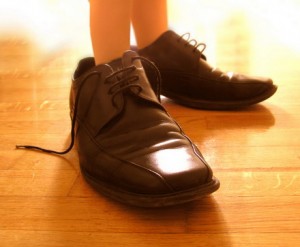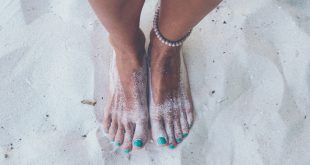What Every Parent Should Know
By Dr. Philip Baldinger –


If choosing to have your child in shoes, the goal is to train the child to walk with as natural a gait as possible. A good quality laced shoe with a soft leather upper is an appropriate choice. The sole should be semi-flexible, flat and not too thick. Heels should be avoided when possible. High-tops are fine, though not necessary.
The Infant’s Foot
Infants and crawlers do not need shoes – only booties, socks or pre-walking shoes that do not bind the feet. An infant’s foot grows at a faster rate than at any other time in life. From birth to 3 years, the foot grows 8-9 full shoe sizes.
An infant’s shoes should never be tight. The children need plenty of room to wiggle their toes. No shoe should have any restrictions across the top of the foot or the ball of the foot. A shoe that is too large, on the other hand, should also be avoided. Wearing a shoe that is too large indicates that the foot size is not being checked with sufficient regularity.
Guidelines for Kid’s Shoes
A good guideline is to check an infant’s feet every two months, while toddlers and older children should be checked every 4-6 months.
Other guidelines include avoiding heels as a high heel impedes natural foot development. Finally, avoid buying shoes into which your child will grow. Shoes that are too large can cause tripping. Look for widths and sizes that allow your child’s feet to grow with minimal interference from the shoe.
Athletic shoes with rubber soles should be avoided until after age 3. After that, the child begins walking with a “heel-to-toe” gait. Prior to age 3, the rubber sole causes the foot to stop rapidly when the child puts his/her foot down which causes the foot to slide forward within the shoe, resulting in toe compression. Also, athletic shoes often do not provide adequate room for the toes.
Shoes should match the shape of the foot. The shape of the show is determined by the model from which the shoe is made. This shape is called a last. A straight last conforms most ergonomically to a child’s foot and should therefore be sought when making a shoe purchase. Most shoes for preschool children are made from straight lasts. Unfortunately, many lasts for older children are flared inward.
Shoe Recommendations Based on Age
Crib Age – A loose fitting soft bootie
1-2 Years – (Toddler) A flexible bootie or shoe with flats stable sole
2-3 Years – (Running Age) A firmer yet still flexible bootie or shoe
3-4 Years – A firmer shoe, bootie or possibly an athletic type of shoe
4+ Years – Walking or athletic shoes are fine for this age group
Tips While In The Shoe Store
Foot size increases with standing as well as with the time of day, so shop for shoes later in the day.
Always have the salesperson measure your child’s feet. When being measured, the child should be standing up and putting full weight on his/her feet. If there is a size difference between the feet, take the larger size.
Once the shoes are on, check them for length and width. While the child is standing, check the toe box. There should be a thumb’s space between the end of the toes and the tip foot of the shoe. For width, check the broadest part of the foot near the ball of the foot. The shoe should neither
be bulging out nor tight. You should be able to grab an inch of leather or canvas. While the child is standing, verify that the child has enough room behind their heel for you to slide your little finger. This will ensure that there is enough room in the toe to allow the foot to grow. Remember that the foot grows backward as well as forward.
The child should try on a pair or shoes and walk about the show for about 5 minutes. Then quickly remove the shoes and examine your child’s feet for redness. Check the small toe, the widest part of the foot near the ball and the back of the heels. Redness indicates pressure. Do not accept discomfort as a normal “breaking in” period. Feet could break in the process!
A child may not complain about discomfort even if shoes are tight. But if they remove shoes frequently, limp or refuse to walk in shoes, suspect misfit. Keep in mind, too, that children’s feet have a way of growing out of their shoes.
If your child needs further care, contact Cortez Foot and Ankle Specialists at 941-758-8818. We’re open 8 am to 5 pm, Monday through Friday and have 3 locations to serve you in Bradenton, Parrish and Sarasota.
www.cortezfootandankle.com
Providing foot and ankle care for families since 1974
Call To Schedule Your Appointment Today!
941-758-8818
 Southwest Florida's Health and Wellness Magazine Health and Wellness Articles
Southwest Florida's Health and Wellness Magazine Health and Wellness Articles

